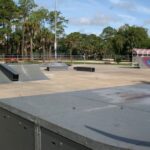The Flagler County School Board held a public meeting on July 29, 2025, to approve its budget and tax rates for the upcoming school year. The meeting resulted in the adoption of the county’s lowest property tax rate for schools in its history; however, board members had differing views on what this means for the community.
Budget Overview
Patty Warnarmac, the district’s budget director, presented the financial plan for the 2025-26 school year. The total budget exceeds $328 million. The district expects to end the current year with $9 million in reserve funds, which represents about 7% of its total revenue. This is well above the state requirement of 3%.
The school system receives money from several sources. The largest portion comes from the state of Florida through a funding formula called the Florida Education Finance Program, often shortened to FEFP. Local property taxes make up another significant portion, while federal grants provide additional support for specific programs like Title I, which helps schools with many low-income students.
Property Tax Rates Hit Historic Low
The school board approved a property tax rate of 5.349 mills. A mill represents one dollar of tax for every thousand dollars of property value. This rate is the lowest in Flagler County’s history, down from a high of over 7 mills back in the mid-1990s.
However, the district cannot set this rate itself. Unlike cities or the county government, school boards must use the tax rate given to them by the state each year. When property values go up in an area, the state typically lowers the school tax rate to balance things out, so districts don’t automatically get more money just because home values increase.
School Choice Impact Creates Divide
The biggest point of disagreement during the meeting centered on Florida’s expanded school choice programs, particularly something called Family Empowerment Scholarships. These vouchers allow parents to use state funding that would normally go to public schools to instead pay for private school tuition or homeschooling expenses.
The amount of money leaving Flagler’s public schools through these vouchers has grown dramatically. In the 2020-21 school year, when the program started, the impact was minimal. For the upcoming 2025-26 year, the district estimates $17 million will go to families choosing alternatives to public school.
Board Chairman Will Furry expressed concerns about this trend. He argued that while the lower tax rate might look good on paper, it creates problems for public schools. According to Furry, schools still need to maintain buildings, staff, and programs even when some students leave, but they lose the funding that goes with those students. He also worried about losing local control, since more education decisions are being made at the state level rather than by local communities.
Furry pointed out that parents always had the right to choose private schools or homeschooling, questioning why taxpayers should now fund choices that were already available. He emphasized that strong public schools benefit everyone in the community, not just families with school-age children, because they create a skilled workforce and increase property values.
Different Perspectives on School Choice
Board member Derek Barrs offered a different viewpoint on the same issue. He argued that the increase in families using vouchers shows the school choice system is working as intended. Barrs said this creates healthy competition that should motivate public schools to prove they offer the best educational option.
Barrs emphasized that school choice helps create equality in education. He explained that families in poor neighborhoods can now afford private school options that were previously only available to wealthy families. Rather than a child’s education being limited by their home address, parents can now choose what they believe is best for their child, regardless of their financial situation.
Barrs expressed confidence that Flagler’s public schools offer an excellent education with great teachers and leadership, and believes parents will recognize this quality when making their choice.
Other Budget Details
The district’s budget includes several different funds for different purposes. Beyond the general operating fund, they have special funds for federal grants, debt payments on borrowed money for building projects, and capital improvements funded by a separate property tax and impact fees from new construction.
The district plans to spend $29 million from capital funds on items like school buses, furniture, equipment, and building maintenance. Most of the general budget, about 83%, goes toward employee salaries and benefits.
Student enrollment continues to grow in Flagler County, though the numbers include students attending charter schools and using virtual learning options, not just those in traditional district schools.
Looking Ahead
The school board meeting concluded with no public comments from community members, though Chairman Furry encouraged more citizens to attend future meetings. Superintendent LaShakia Moore announced that teachers will return to work the following week, with the first day of school scheduled for August 11th.
The board’s unanimous approval of both the tax rate and budget sets the stage for the upcoming school year, though the ongoing debate about school choice and its effects on public education funding will likely continue as the state program expands further.








